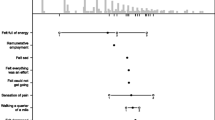Abstract
Health questionnaires and scales are widely used instruments for assessing various aspects of health. A well-established health questionnaire is important for the detection of reversible health damages that could not be measured directly. In this chapter, some key issues in the development and evaluation of health scales and questionnaires were presented and discussed, including the procedure of questionnaire development, assessment of reliability and validity.
Access this chapter
Tax calculation will be finalised at checkout
Purchases are for personal use only
Similar content being viewed by others
Abbreviations
- M-M:
-
Multi-trait-multi-method
- MMSE:
-
Mini-Mental State Examination
- MPQ:
-
McGill pain questionnaire
- SHS:
-
Suboptimal health status
- SHSQ-25:
-
Suboptimal health status questionnaire-25
References
Keszei AP, Novak M, Streiner DL (2010) Introduction to health measurement scales. J Psychosom Res 68(4):319–323. https://doi.org/10.1016/j.jpsychores.2010.01.006
McDowell I (2010) Measures of self-perceived well-being. J Psychosom Res 69(1):69–79. https://doi.org/10.1016/j.jpsychores.2009.07.002
Yan YX, Liu YQ, Li M, Hu PF, Guo AM, Yang XH, Qiu JJ, Yang SS, Shen J, Zhang LP, Wang W (2009) Development and evaluation of a questionnaire for measuring suboptimal health status in urban Chinese. J Epidemiol 19(6):333–341. https://doi.org/10.2188/jea.je20080086
Gagnon M, Letenneur L, Dartigues JF, Commenges D, Orgogozo JM, Barberger-Gateau P, Alpérovitch A, Décamps A, Salamon R (1990) Validity of the mini-mental state examination as a screening instrument for cognitive impairment and dementia in French elderly community residents. Neuroepidemiology 9(3):143–150. https://doi.org/10.1159/000110764
Melzack R (1975) The McGill pain questionnaire: major properties and scoring methods. Pain 1(3):277–299. https://doi.org/10.1016/0304-3959(75)90044-5
Panagiotakos D (2009) Health measurement scales: methodological issues. Open Cardiovasc Med J 3:160–165. https://doi.org/10.2174/1874192400903010160
Likert R (1932) A technique for the measurement of attitudes. Arch Psychol 140:5–55
Andrich D (2011) Rating scales and Rasch measurement. Expert Rev Pharmacoecon Outcomes Res 11(5):571–585. https://doi.org/10.1586/erp.11.59
Carmines E, Zeller R (1986) Reliability and validity assessment. Sage Publications, London
Lohr KN, Aaronson NK, Alonso J, Burnam MA, Patrick DL, Perrin EB, Roberts JS (1996) Evaluating quality-of-life and health status instruments: development of scientific review criteria. Clin Ther 18(5):979–992. https://doi.org/10.1016/s0149-2918(96)80054-3
Gage M, Noh S, Polatajko HJ, Kaspar V (1994) Measuring perceived self-efficacy in occupational therapy. Am J Occup Ther 48(9):783–790. https://doi.org/10.5014/ajot.48.9.783
Spearman C (1910) Correlation calculated from faulty data. Br J Psychol 3:271–295
Brown W (1910) Some experimental results in the correlation of mental abilities. Br J Psychol 3:296–322
Rosenthal R, Rosnow RL (1991) Essentials of behavioral research: methods and data analysis. McGraw-Hill, Boston, MA
Ware JE Jr, Gandek B (1998) Methods for testing data quality, scaling assumptions, and reliability: the IQOLA project approach. International quality of life assessment. J Clin Epidemiol 51(11):945–952. https://doi.org/10.1016/s0895-4356(98)00085-7
Polit DF, Beck CT, Owen SV (2007) Is the CVI an acceptable indicator of content validity? Appraisal and recommendations. Res Nurs Health 30(4):459–467. https://doi.org/10.1002/nur.20199
Cronbach LJ, Meehl PE (1955) Construct validity in psychological tests. Psychol Bull 52(4):281–302. https://doi.org/10.1037/h0040957
Comrey AL, Lee HB (1992) A first course in factor analysis, 2nd edn. Lawrence Erlbaum Associates, Hillsdale, NJ
Kline RB (1998) Principles and practice of structural equation modeling. Guilford Press, New York
Caracciolo B, Giaquinto S (2002) Criterion validity of the center for epidemiological studies depression (CES-D) scale in a sample of rehabilitation inpatients. J Rehabil Med 34(5):221–225. https://doi.org/10.1080/165019702760279215
Strauss ME, Smith GT (2009) Construct validity: advances in theory and methodology. Annu Rev Clin Psychol 5:1–25. https://doi.org/10.1146/annurev.clinpsy.032408.153639
Ferketich SL, Figueredo AJ, Knapp TR (1991) The multitrait-multimethod approach to construct validity. Res Nurs Health 14(4):315–320. https://doi.org/10.1002/nur.4770140410
Author information
Authors and Affiliations
Corresponding author
Editor information
Editors and Affiliations
Ethics declarations
None.
Rights and permissions
Copyright information
© 2024 The Author(s), under exclusive license to Springer Nature Switzerland AG
About this chapter
Cite this chapter
Yan, YX., Wang, W. (2024). Approaches for Measuring Reversible Damage to the Health. In: Wang, W. (eds) All Around Suboptimal Health . Advances in Predictive, Preventive and Personalised Medicine, vol 18. Springer, Cham. https://doi.org/10.1007/978-3-031-46891-9_8
Download citation
DOI: https://doi.org/10.1007/978-3-031-46891-9_8
Published:
Publisher Name: Springer, Cham
Print ISBN: 978-3-031-46890-2
Online ISBN: 978-3-031-46891-9
eBook Packages: Biomedical and Life SciencesBiomedical and Life Sciences (R0)




